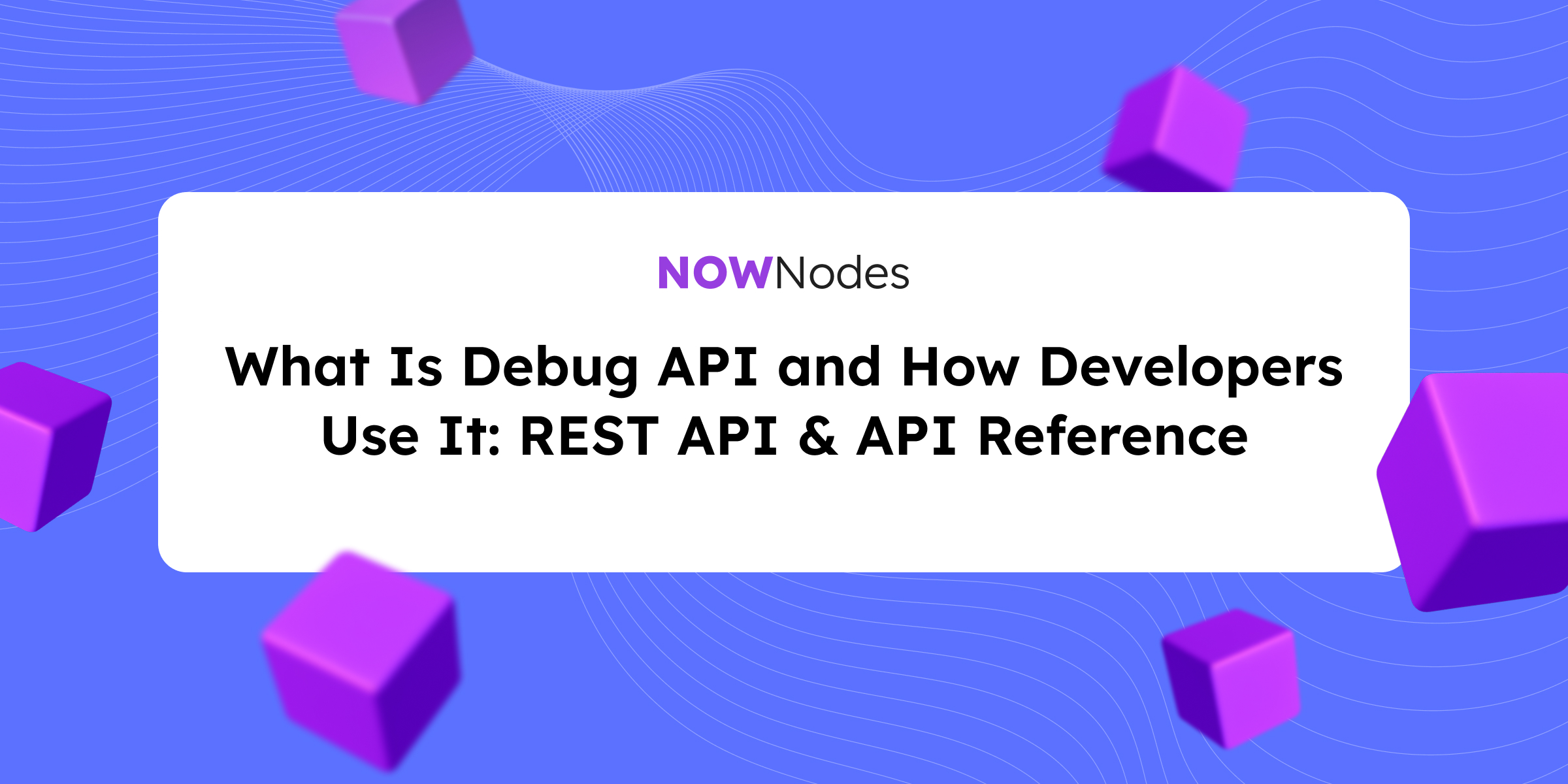Working with EVM blockchains eventually brings every developer to the same moment: the contract should behave one way, but the chain insists otherwise. The transaction fails silently, gas burns, the api returns a generic message, and suddenly you’re staring at logs trying to identify the root cause hidden somewhere in the execution path. This is where the Debug API from NOWNodes becomes more than a convenience — it becomes a critical debugging partner.
Unlike basic calls to an Ethereum node, which reveal only the outer shell of the transaction, the debug api exposes the full call stack, internal calls, gas usage, and revert reasons. And because NOWNodes operates as a high-availability node provider, its api delivers the stable infrastructure required for intensive tracing, repeated api request loops, and continuous debugging requests even in large production environments.
What makes NOWNodes particularly developer-friendly is the consistency of its rpc provider interface: every api call strictly follows JSON-RPC standards, supports granular options, and behaves predictably whether you’re using postman, devtools inside a browser, command line scripts, or a backend service that needs to inspect transactions during runtime.
Why Debugging on EVM Requires More Than Logs
Experienced engineers know that debugging means going deeper than checking revert messages. You need to understand how the transaction evolved, how each internal call behaved, what the server returns, and whether a misconfigured request header or malformed payload is shaping the result.
Smart contracts often fail for subtle reasons:
- a state change blocked by an earlier require,
- an unexpected delegatecall path,
- wrong calldata coming from client-side code,
- or even incorrect assumptions in the sequence of calls across http requests and responses.
This is where enable tracing becomes invaluable.
Tracing exposes the entire internal structure of execution, allowing you to inspect the request, compare headers and body, validate authentication, check the url, and ultimately identify the root cause with precision that ordinary logs can’t achieve.
Example of Debug API Request
NOWNodes exposes classic Ethereum debugging endpoints like debug_traceTransaction, but the difference lies in reliability and ease of integration. The api supports a variety of tracers, which makes the process far more flexible for engineers building web app, desktop app, or automated non-browser pipelines.
Before You Start: Getting Your NOWNodes API Key
To execute any debug api workflow, you need a valid NOWNodes API key. The process is intentionally lightweight so developers can move straight into debugging without setup friction:
- Visit the NOWNodes dashboard and create an account.
- (if you have chosen a Start Plan) Choose the network you want to work with — Ethereum, Arbitrum, or other EVM chain.
- Generate an API key inside your workspace.
- Use this key for every api call you make, passing it through the
api-keyrequest header.
Once the key is active, the api supports immediate use across all networks, environments, and rest api integrations. With authentication in place, you can proceed directly to your first tracing request:
Below is the canonical http request example that most developers start with when troubleshooting contract behavior. It is compatible with CLI, postman, or any api server workflow.
curl -L \
--request POST \
--url 'https://eth.nownodes.io/' \
--header 'api-key: YOUR_API_KEY' \
--header 'Content-Type: application/json' \
--data '{
"jsonrpc": "2.0",
"method": "debug_traceTransaction",
"params": [
"0x9e63085271890a141297039b3b711913699f1ee4db1acb667ad7ce304772036b",
{
"tracer": "callTracer"
}
],
"id": 1
}'Because the api is uniform across networks, switching chains or environments doesn’t require rewriting your logic — a necessity for production infrastructure that relies on developing apis, orchestration tools, and sdks that must remain chain-agnostic.
Real-World Debug API Responses
A typical debug_traceTransaction response from NOWNodes looks like this:
{
"jsonrpc": "2.0",
"id": 1,
"result": {
"type": "CALL",
"from": "0x688c1de81ce07a698679928ae319bbe503da1a5d",
"to": "0xf15176bc2a8d95102e21641fc0c3b1a9990d2d2d",
"value": "0x0",
"gas": "0x226c9",
"gasUsed": "0x1a529",
"input": "0xaea01419000000000000000000000000000000000000000000000000000000000000006000000000000000000000000000000000000000000000000000000000000000a000000000000000000000000000000000000000000000000000000000000000e00000000000000000000000000000000000000000000000000000000000000001000000000000000000000000000000000000000000000000000000000000000500000000000000000000000000000000000000000000000000000000000000010000000000000000000000000000000000000000000000000000000000000001000000000000000000000000000000000000000000000000000000000000000b7180b07bd1906c59af640bd8eeab367b7594f9af0fc90ecd5ebe7c0a1be8a4e536f3393fd943b12745241929d83318675e662c725c1ede53fcb3b8396277bf617b5839bd4d6e005d4dda81701f87378e34cb9cbd113c435db0c10ac07f2465579615210131a0c66381308e606e3b6da4a360285b8865010f14d3c3f92aa9043d6d48b0e6493b6b63887c0fbfe88c48d280c01cbf4df2a77a7221536436b02c0382ab5368bb19710ec9ba7bf6375faf6d4936e21152556361682e63b083f0b61402ac2171cc082861c603adf7e26abfc9c196e8fe07491088f1a887a8e2124e90f9b26afe29ac9f0c44594eb6ad83ce13fc4362fb86cd71e5d8133548a9ed2165d90a60b7959951ce31ebe733f8e648987339c66246b7dcab61eae5c6f95604a2133af90e4ee678878c0c249c07e4f3159c5e7bef52a67baf54e075715cc39b4795940b8f2632eabc4a68d61d83c4ed2a4b4a2a1d80da98ee8a74a0d497924866",
"output": "text",
"error": "text",
"revertReason": "text",
"calls": [
{}
]
}
}This response is a textbook example of how the Debug API exposes the internal structure of a transaction. You immediately see the outer call context—from, to, gas, and gasUsed—which allows you to evaluate execution cost and determine whether gas exhaustion contributed to a failure.
The input field shows the raw calldata, useful for verifying encoding, especially when debugging client-side logic or backend request generation.
Fields like error and revertReason remain empty here, meaning the transaction didn’t surface a top-level revert, but the presence of a calls array (even when minimal) tells you that internal calls occurred and can contain additional diagnostic layers.
This kind of structured output enables engineers to reconstruct the execution path with precision, compare expected behavior with actual runtime conditions, and quickly isolate the root cause without digging through guesswork or incomplete logs.
API Debugging in Practice: How Engineers Use It
What makes debugging on NOWNodes efficient is the combination of infrastructure stability and transparent api behavior. The workflow usually looks like this:
- Capture the failing transaction hash.
- Reproduce the error using the debug api.
- Compare internal operations with expected behavior.
- Examine response body, response headers, error structure, and gas flow.
- If inconsistent, inspect the request parameters, check the ssl certificate, validate authentication, and confirm the request method.
- If still unclear — restart from the call stack and follow the sequence of calls to pinpoint the deviation.
This is where NOWNodes proves its value: the underlying infrastructure supports high-volume http request bursts, reliable replaying, api debugging, remote debugging, and even internal tooling integration inside corporate pipelines or a management service environment.
Why Developers Prefer NOWNodes for Debug Tracing
Developers who rely on best free api access tiers, enterprise-grade uptime, or consistent cross-chain tooling find that NOWNodes gives them:
- deterministic api latency,
- easy orchestration across chains,
- predictable behavior for debugging api requests,
- stability for long-running automation,
- seamless integration with rest api systems and rest apis that demand uniformity.
And above all — the certainty that the platform used won’t distort results, even under intense http traffic.
Final Thoughts
Debugging smart contracts is fundamentally about clarity: seeing the invisible and narrowing down the exact root cause of the issue buried somewhere inside complex logic. With NOWNodes, developers get a stable, transparent, deeply configurable api that supports meaningful tracing and high-quality introspection. Combined with the flexibility to use tools like visual studio, dev tools, command line, or postman, it forms a complete, modern debugging environment that shortens development cycles and improves production reliability.



